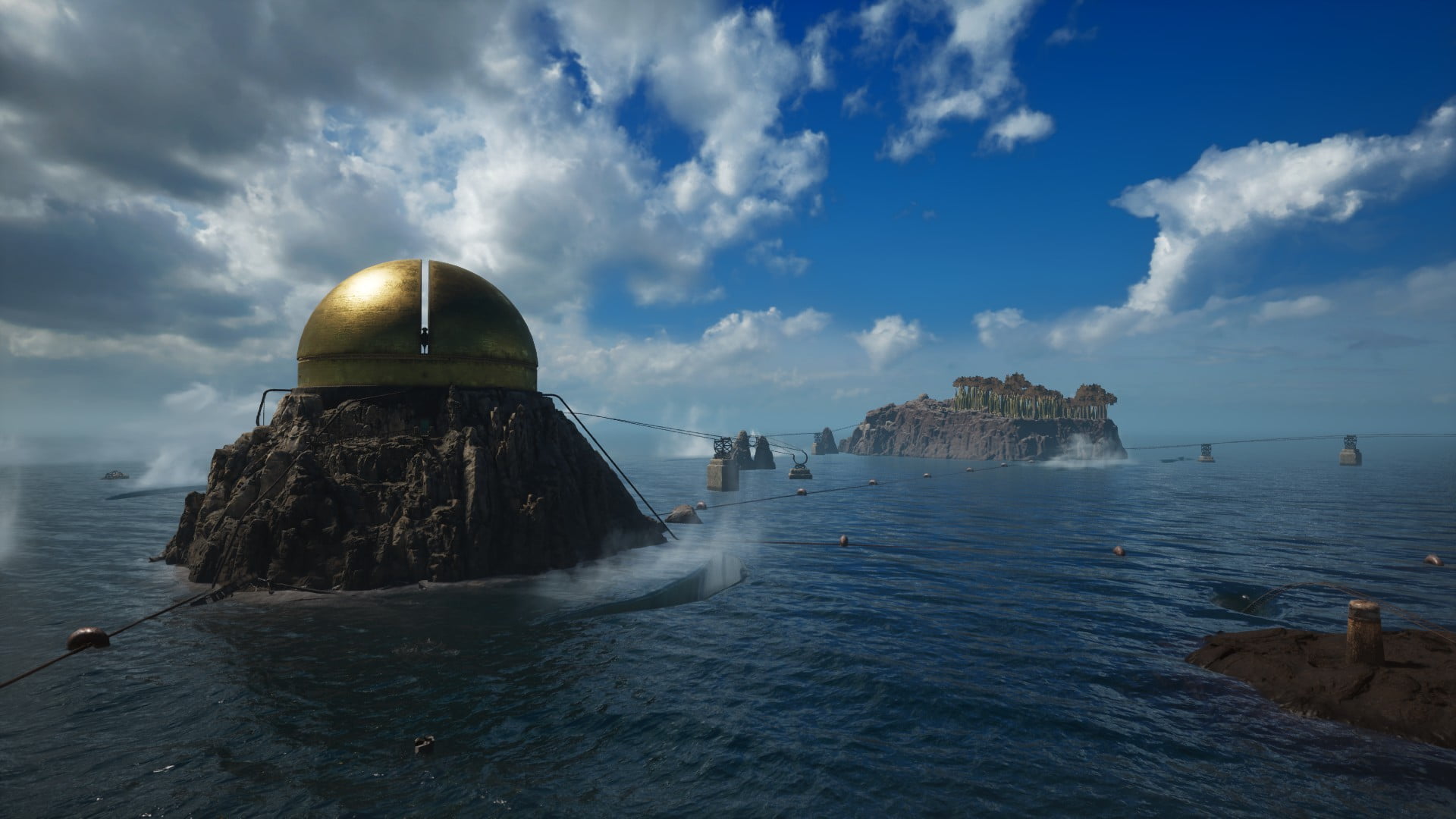With the Dark Souls series having come to an end, plenty of developers are looking to fill that void. We’ve already seen a couple of Souls-likes this year, with DarkMaus and Salt and Sanctuary delivering top-down and side-scroller takes on From Software’s flagship franchise, but they’re hardly the last we’ll see in 2016.
I saw a fair number of games drawing from the Souls series at this year’s E3, all of them taking much different approaches. From the close adherence to the formula established by From Software in Eitr and Death’s Gambit, to the procedural level generation of Necropolis and the sci-fi setting of The Surge, there’s gonna be no shortage of ways to get your Dark Souls fix in the coming months.

The Surge
The Surge looks to be to Lords of the Fallen what Bloodborne was to Dark Souls; that is, a faster take on its predecessor. This time developer Deck 13 has left the fantasy setting behind for a sci-fi aesthetic this time. Set in a near-future dystopia where Earth’s climate has become increasingly polluted, you play as an as of yet unnamed protagonist whose job was to help cleanse the rampant pollution who finds himself in a bad situation. Robots have gone rogue and co-workers have turned into basically zombies. We didn’t get much in the way of specifics of the story during the hands-off demo we were shown, though they’re apparently cutting out cutscenes for a greater focus on environmental storytelling.
The demo ran us through a scrapyard. Shipping containers and decrepit machinery lay scattered everywhere. The level design seemed straightforward, looping back around on itself through shortcuts that open up as you move through the area. Combat looks to have the same weight that Lords of the Fallen had, every swing having a very pronounced wind-up, though the overall flow of battle looked faster, but it was hard to say for sure given the demo was hands-off. Hopefully it won’t feel as sluggish as Lords of the Fallen.
Though the combat looks like standard fare Souls-like action, there a few unique additions, most notably the ability to target specific limbs. When you lock-on to an enemy, several white dots appear on their body, allowing you to focus your strikes on their arms or head. By doing so, you can cut those limbs off to get new pieces or armor for your exosuit. For instance, the developer running the demo decapitated an enemy and picked up his head. Suddenly a text pop-up says he got a helmet. Brutal. You can also upgrade your exosuit at operating stations, which act as the game’s hub. We didn’t get to see them in action, though.
After fighting through hordes of shambling workers and a few robots, we came upon a boss. A large defense drone of sorts – lot like the one in the image above – equipped with some heavy artillery. There are multiple ways to take it down based on your loadout, the developers said. They were equipped with an axe, so they chipped away at the armor on its legs so they could attack the circuitry underneath. When enough damage is dealt, the robot falls to its knees, allowing them to attack its head for greater damage. A couple more cycles of that and the boss was defeated, thus concluding the demo.
The Surge will arrive next year on PC, PlayStation 4, and Xbox One.

Necropolis
Harebrained Schemes’ latest draws some inspiration from Dark Souls and co., but only a little. Necropolis is a roguelike where you seek to escape a sprawling dungeon. It’s based around performing multiple runs, as there’s an element of persistence and progression. The E3 demo was only ten minutes long, so I didn’t get a whole lot of time to explore its depths, but I liked what I saw.
The demo threw me right into the midst of a pre-made dungeon. With only ten minutes to explore, I didn’t spend much time carefully examining my surroundings. I just found the nearest doorway or stairwell and pressed forward. I received a few objectives from a mysterious voice in what looked to be a hub of sorts. One corner of the room had a bookshelf containing scrolls collected on previous runs, although there wasn’t anything to read at the moment. I didn’t get a look at what the objectives were, unfortunately, because they disappeared soon after I left the room. With no specific goals in mind, I kept wandering around, fighting whatever adversaries came my way.
Combat is where Necropolis gets that Souls-like feel. From the mechanics down to the controls themselves, the combat plays very similar to Dark Souls. There was a weird lack of consistency between swing speed of similar weapon types – I tried two different swords while I played, and the default one was noticeably slower than one I picked up off a fallen foe, despite being the almost the same in every respect. That’s one interesting element to Necropolis: you can pick up and discard enemy weapons at will. Maybe picking up those weapons will unlock them for use from the start for future runs? Didn’t get a chance to check because, you know – ten minute demo. Wasn’t long after that I died after foolishly taking on a bigger group than I could handle. A stats screen came up taking stock of how far I got and any items I found. Didn’t unlock anything, unfortunately. Probably because I didn’t complete any of those objectives.
Necropolis launches on PC on July 12, and on PlayStation 4 and Xbox One later in Summer.

Eitr
The Dark Souls inspirations are a lot more shameless in Eitr, a Norse mythology-themed dungeon crawler by Eneme Entertainment. I picked up the demo from where someone else left off, so I didn’t get a sense of what the framing for this particular area was. The game’s general premise involves the protagonist, known only as the Shield Maiden, on a quest to cleanse the tree Yggdrasil of darkness across several worlds. The one featured in the demo was an underground complex of sorts. Low visibility and the occasional skeleton – which seem to serve as this game’s analog to notes – set the mood nicely along with the quiet hum of the wind echoing through the area.
I wandered around for a while trying to get my bearings. With few landmarks to speak of it was difficult to tell where I was at any given moment. The occasional gate and trap gave me something to build a mental map off of, but just barely. I didn’t get very far into the level, however, as I kept dying. Combat is slow and methodical. Where most of these games have pushed for a focus on offense, Eitr doubles-down on defense. The Shield Maiden has little mobility. You can dodge attacks, but the recovery period means you probably won’t turn around and immediately counterattack. As such, the combat in Eitr feels more focused on dodging only when necessary and blocking when you want to attack. It almost like an exact copy of combat in early Souls games, which isn’t a bad thing. The slower pace fits the tone of the game well and adds to the tension of exploring these dark spaces.
One thing about the demo that stood out: at the base of the health and stamina bars was a number, similar to the number of Humanity you carried in Dark Souls. Didn’t see it rise during my brief time with the game, nor did any of the notes I found mention it. Curious.
Eitr will be out on PlayStation 4 and PC sometime this year.

Death’s Gambit
Though Eitr was certainly obvious in how much it borrows from Dark Souls, Death’s Gambit goes even further. Like Salt and Sanctuary from earlier this year, Death’s Gambit from developer White Rabbit is essentially a 2D side-scroller take on the Souls formula – a very stylish one too.
The demo began just outside a decrepit castle. Undead soldiers armed with crossbows lined the road to the gate, along with a few wielding swords. A quick swing of my blade took them down. Eventually I reached a hole in front of a large staircase. I thought about ascending to see what lie deeper in the castle, but a dragon swooped down and doused it in flames just as I approached. Down the hole it was then.
The path diverged here, both roads leading to bosses. The first was a large knight situated somewhere higher in the castle that could call in reinforcements (the developer told me he was also the harder of the two fights), and the second a monster that was a strange mix of flesh and bone – the one you see in the image above. That fight in particular was set on a precarious slab of land. If the weight distribution isn’t even, it’ll topple over and you’ll fall to your death. I didn’t have much luck against either of them. Between their relentless attacks and swift movements, I never lasted long before they overwhelmed me. Fighting with a slow greatsword didn’t help my chances, either.
The hook of Death’s Gambit is how it challenges you to beat bosses in as few tries as possible. When playing online, the game keeps track of the average amount of tries it takes players to defeat a boss. Finish it under the par and you’ll receive greater rewards. You can also lower the amount of phoenix feathers – your healing items – you carry to double your experience points. You can also fight bosses again, as they are immortal. Depending on how you defeat them, you might earn different rewards. It’s an interesting hook.
Death’s Gambit will be out on PlayStation 4 and PC sometime next year.




